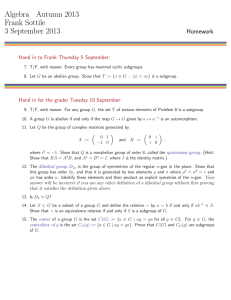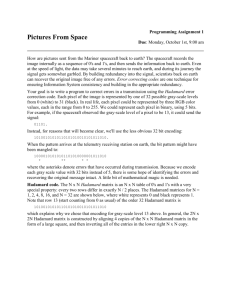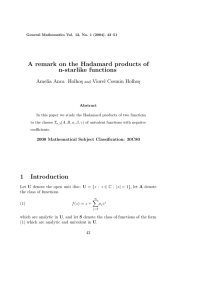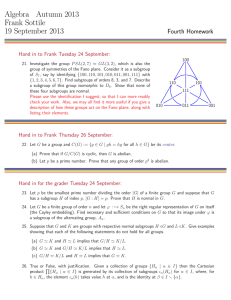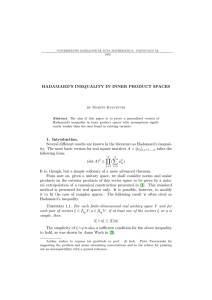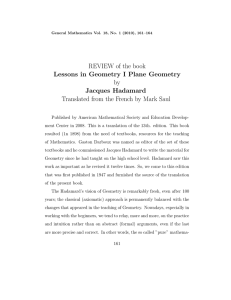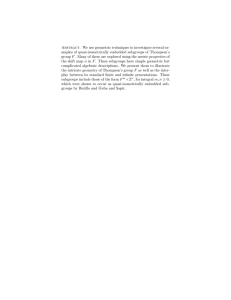Acta Mathematica Academiae Paedagogicae Ny´ıregyh´aziensis 24 (2008), 309–311 www.emis.de/journals ISSN 1786-0091
advertisement
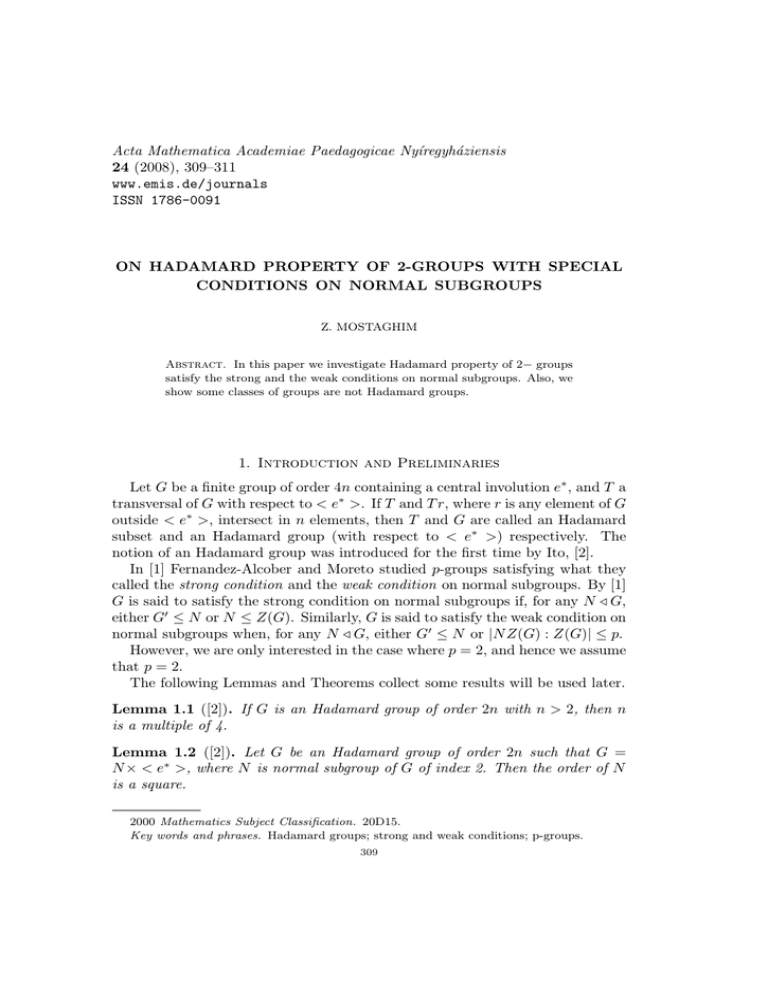
Acta Mathematica Academiae Paedagogicae Nyı́regyháziensis 24 (2008), 309–311 www.emis.de/journals ISSN 1786-0091 ON HADAMARD PROPERTY OF 2-GROUPS WITH SPECIAL CONDITIONS ON NORMAL SUBGROUPS Z. MOSTAGHIM Abstract. In this paper we investigate Hadamard property of 2− groups satisfy the strong and the weak conditions on normal subgroups. Also, we show some classes of groups are not Hadamard groups. 1. Introduction and Preliminaries Let G be a finite group of order 4n containing a central involution e∗ , and T a transversal of G with respect to < e∗ >. If T and T r, where r is any element of G outside < e∗ >, intersect in n elements, then T and G are called an Hadamard subset and an Hadamard group (with respect to < e∗ >) respectively. The notion of an Hadamard group was introduced for the first time by Ito, [2]. In [1] Fernandez-Alcober and Moreto studied p-groups satisfying what they called the strong condition and the weak condition on normal subgroups. By [1] G is said to satisfy the strong condition on normal subgroups if, for any N / G, either G0 ≤ N or N ≤ Z(G). Similarly, G is said to satisfy the weak condition on normal subgroups when, for any N / G, either G0 ≤ N or |N Z(G) : Z(G)| ≤ p. However, we are only interested in the case where p = 2, and hence we assume that p = 2. The following Lemmas and Theorems collect some results will be used later. Lemma 1.1 ([2]). If G is an Hadamard group of order 2n with n > 2, then n is a multiple of 4. Lemma 1.2 ([2]). Let G be an Hadamard group of order 2n such that G = N × < e∗ >, where N is normal subgroup of G of index 2. Then the order of N is a square. 2000 Mathematics Subject Classification. 20D15. Key words and phrases. Hadamard groups; strong and weak conditions; p-groups. 309 310 Z. MOSTAGHIM Lemma 1.3 ([2]). Let Gi be an Hadamard group of order 2ni with prescribed subset Di and element e∗i (i = 1, 2). Then G = G1 × G2 / < e∗1 e∗2 > is an Hadamard group of order 2n1 n2 with prescribed subset D = D1 D2 < e∗1 e∗2 > considered as the set of cosets and element e∗ = e∗1 < e∗1 e∗2 >. Lemma 1.4 ([2]). Let G be an Hadamard group of order 2n = 2k m with m odd and S a Sylow 2-subgroup of G. Then S is not a dihedral or a cyclic group. Theorem 1.5 ([1]). (i) If G satisfies the strong condition on normal subgroups, then it has nilpotency class c ≤ 3, and if c = 3 then |G : Z(G)| = p4 . (ii) If G satisfies the weak condition on normal subgroups, then it has nilpotency class c ≤ 4. If c = 4 then |G : Z(G)| = p4 , whereas for c = 3 we have |G : Z(G)| = p3 , p4 or p6 for odd p and |G : Z(G)| = 23 or 24 when p = 2. Theorem 1.6 ([1]). Let G be a p-group. (i) If G satisfies the strong condition on normal subgroups and has nilpotency class 3, then |G| ≤ p5 . Furthermore, if p = 2 then |G| = 24 , that is, G has maximal class. (ii) If G satisfies the weak condition on normal subgroups and has nilpotency class 4, then |G| ≤ p6 . Furthermore, if p = 2 then |G| = 25 , that is, G has maximal class. (iii) If G satisfies the weak condition on normal subgroups, has nilpotency class 3 and |G : Z(G)| = p6 , then G has bounded order. In fact, |G| ≤ p18 . 2. Main results Theorem 2.1. (a) Let G be an elementary abelian 2-group of non-square order. Then G is an Hadamard group. (b) Let G be an elementary abelian 2-group of square order. Then G is not an Hadamard group. Proof. (a)We show by induction that G is an Hadamard group. It is obvious for elementary abelian 2-groups of orders 2 and 8. We describe D and e∗ for this groups in section 3. Now let G be an elementary abelian 2-group of order 22k+1 and G be an Hadamard group, with prescribed subset D1 and element e∗1 . Also H be an elementary abelian 2-group of order 8, with prescribed subset D2 and element e∗2 . By Lemma 1.3, G × H/ < e∗1 e∗2 > is an elementary abelian Hadamard group of order 22k+3 . It is easy to see that the isomorphic image of an Hadamard group is an Hadamard group. This completes the proof. (b) Assume on the contrary that G is an Hadamard group. We can consider |G| = 22n and G = N × < e∗ >, where N B G, |N | = 22n−1 . By Lemma 1.2, this is impossible. This shows that G is not an Hadamard group. ¤ Corollary 2.2. The elementary abelian 2-group of non-square order is an Hadamard group with respect to every element of order 2. ON HADAMARD PROPERTY OF 2-GROUPS 311 Corollary 2.3. Non-abelian 2-groups of square order that all of subgroups are normal are Hadamard groups. Corollary 2.4. A non-cyclic finite 2-group with exactly one subgroup of order 2 is an Hadamard group. By Theorems 1.5 and 1.6 we have Theorem 2.5. Let G be a 2-group. (a) If G satisfies the strong condition on normal subgroups and has nilpotency class 3 and G is not a semidihedral group, then G is an Hadamard group. (b)If G satisfies the weak condition on normal subgroups and has nilpotency class 4 and G is not a semidihedral group, then G is an Hadamard group. Now we consider non-abelian finite groups that are not 2-groups and all of proper subgroups are abelian. Theorem 2.6. Let G be a non-abelian finite group which is not a 2-group and all of proper subgroups of G are abelian. Then G is not an Hadamard group. Proof. It is easy to see that G is a p-group or |G| = pa q b where p and q are distinct primes. In the latter, one of Sylow subgroups of G is cyclic and another Sylow subgroup is normal and elementary abelian. If G be a p-group, it is obvious that G is not an Hadamard group. Let |G| = pa q b and p < q. We consider the following cases. Case 1. If p 6= 2, q 6= 2, then by Lemma 1.1 G is not an Hadamard group. Case 2. Let p = 2 (a) If 2-Sylow subgroup is cyclic, then by Lemma 1.4 G is not an Hadamard group. (b) Let P be 2-Sylow subgroup of G. Then P B G and elementary abelian. Therefore q-Sylow subgroup of G is cyclic. Since all of Sylow subgroups of G is abelian, then G0 ∩ Z(G) = 1. Let 2||Z(G)|, then Z(G) ⊆ P . Since P B G, then [P, G] < P and therefore [P, G] = 1. So we have P = Z(G). Then for all of q-Sylow subgroups of G, we have P ≤ C(Q) where Q ∈ sylq (G). This is impossible. So 2 - |Z(G)|. Then G is not an Hadamard group. ¤ References [1] G. A. Fernández-Alcober and A. Moretó. Groups with two extreme character degrees and their normal subgroups. Trans. Amer. Math. Soc., 353(6):2171–2192 (electronic), 2001. [2] N. Ito. On Hadamard groups. J. Algebra, 168(3):981–987, 1994. Department of Mathematics, Iran University of Science and Technology, Tehran, Iran E-mail address: mostaghim@iust.ac.ir

